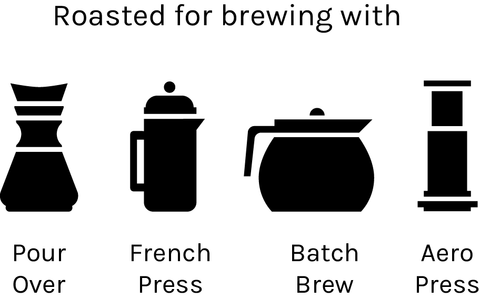Kagumoini, Kenya - Filter Roast
Cranberry, Blood Orange, Nougat
$26.00
This variant is currently sold out
Kagumoini is a washing station (or factory, as they are called in Kenya) located in Murang’a County in Kenya’s former Central Province. Built in 1994, it is one of four active washing stations – along with its sisters Wahundura, Riakiberu and Karugiro – owned by the Kamachiria Coffee Farmers’ Cooperative Society (FCS). Kamachiria is made up of over 5,600 producers who farm in Kenya’s central highlands.
The coffees in this lot are grown in the foothills of the extinct volcano, Mt Kenya, in an area defined by its bright red, nutrient-rich, volcanic soil, high elevations and cool climate, all of which contribute to the outstanding quality of coffees produced here. Most farmers in Murang’a are smallholder cooperative members – with farm size averaging just one hectare – and grow coffee as a cash crop alongside food crops like banana, maize, macadamia, avocados and vegetables. Tea and dairy are also important sources of income for the producers.
Many of the producers in the region are second-generation landholders, whose parents purchased and planted the land. Most coffee farms in Murang’a were planted in the 1950s, after agricultural reform allowed for small Kenyan farmers to produce cash crops on their family farms (instead of only on large, British owned estates). At that time, it was recommended to plant SL-28 and SL-34, which remain the predominant varieties found in the area and make up over 50% of this lot. Both cultivars have Bourbon and Moka heritage and are named after the laboratory that promoted their wider distribution in Kenya during the early 20th Century: Scott Laboratories. This lot also contains the hybrid varieties Ruiru 11 and Batian, which have been bred specifically for their high yields and disease resistance coupled with a high potential for excellent cup quality.
HOW THIS COFFEE WAS PROCESSED
All the coffee cherry is hand-picked and delivered on the same day to the washing station, where it undergoes meticulous sorting. This is also done by hand and is overseen by a ‘cherry clerk’ who ensures any unripe and damaged cherries are removed. The ripe cherry is then weighed and recorded, and the farmer receives a receipt of delivery.
The coffee is then placed in a receiving tank and pulped using a three-disc pulping machine to remove the skin and fruit from the inner parchment layer that protects the green coffee bean. After being pulped, the coffee is sorted by weight using water, with the highest quality and densest beans being separated out from the lighter, lower-quality beans.
The coffee is then dry fermented for 16–24 hours, to break down the sugars and remove the mucilage (sticky fruit covering) from the outside of the beans. Whilst the coffee is fermenting it is checked intermittently and when it is ready it is rinsed and removed from the tanks and placed in a washing channel.
The parchment-covered coffee is then washed with fresh water from the nearby Thuru Thuru River and sent through water channels for grading by weight. The heavier coffee, which sinks, is considered the higher quality, sweeter coffee, and any lighter density or lower grade coffee beans are removed. The beans are then sent to soaking tanks where they sit underwater for a further 24 hours. This process increases the proteins and amino acids, which in turn heightens the complexity of the acidity.
After soaking, the coffee is pumped onto deep drying beds where they drain for 1-2 hours, before being transferred to raised drying tables. For the first six hours of drying, parchment is spread into very thin layers before being bunched into thicker ones. As they dry the parchment is turned constantly to ensure even drying, and so that any defective beans can be identified removed. Time on the drying tables depends on the weather, ambient temperature and processing volume: taking up to ten days to get to the target moisture of 11–12%. After drying the coffee is moved to conditioning beds, where it rests in parchment for about a month. This resting period helps to stabilise water activity and contributes to long-lasting quality and vibrancy in the cup.
























